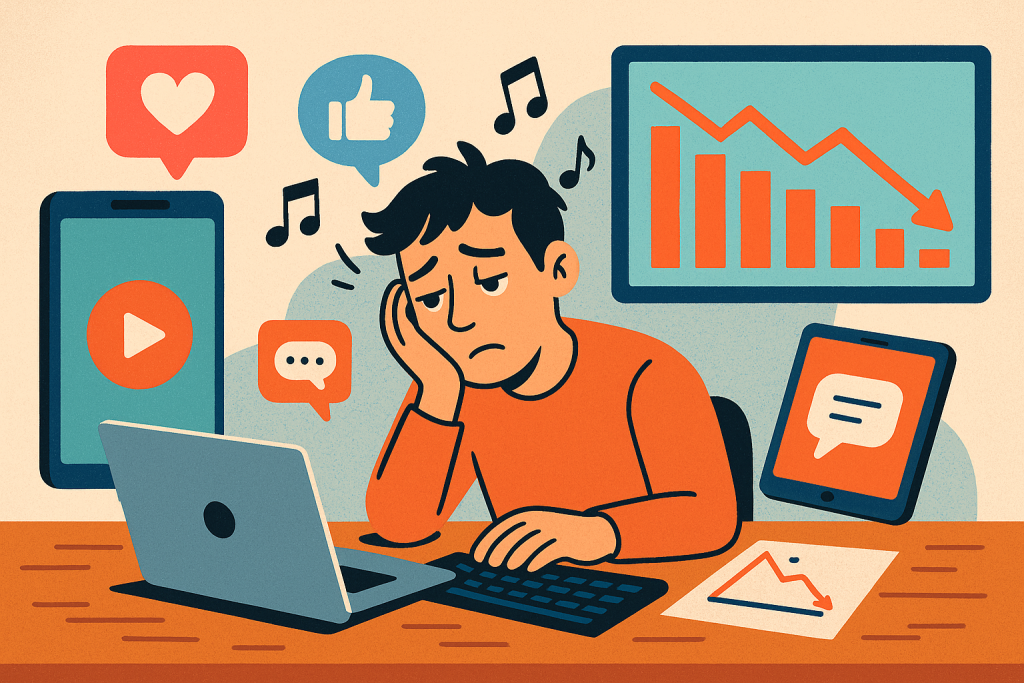Does your phone quietly drain your focus as you scroll through mindless feeds? Mindless technology and productivity aren’t strangers—this article exposes the hidden cost and shares real fixes.

1. What Is “Mindless Technology”?
“Mindless technology” refers to apps and digital tools that invite passive, low-effort engagement—think infinite social feeds, push notifications, and auto-play features. They demand little mental effort but fragment attention, pushing users into a mode called “continuous partial attention”.
Why It’s a Problem
- Constant interruptions—from notifications to autoplay.
- Fragmented focus—we multitask digitally rather than work deeply.
- Symptom of technostress—mental fatigue from relentless digital contacts.
2. The Science: Attention Fragmentation = Weaker Performance
Studies show media multitasking results in cognitive costs—slower task-switching and reduced memory. Frequent task shifts derail deep thinking and slow task completion rates.
In hospital and office contexts, technostress lowers job satisfaction, performance, and longevity.
3. The Bigger Picture: Brain Capital in Peril
At a macro level, rising screen time and digital fragmentation harm our collective “brain capital”—the cognitive skills critical in a tech-forward economy. The Financial Times notes that tech use has undermined attention, creativity, and analytical thinking.
4. The Current Debate: AI Saving Focus… or Making It Worse?
Opinions diverge:
- Optimists liken AI’s transformative potential to the internet boom of the 1990s .
- Cautious voices warn that AI might widen inequality, displace workers, or worsen brain drain newyorker.com.
- Upset users report that AI tools actually hamper productivity—77% of workers say they’ve experienced increased workload and less output since using AI.
5. Red Flags: Are You Losing Productivity to the Screen?
Watch for these signs:
- Always checking notifications (email, Slack, social).
- Feeling anxious or disconnected without your device.
- Inability to finish tasks without digital detours.
- Burnout or stress amplified by daily distractions.
A small study had volunteers mute notifications for 24 hours—they felt more productive but also a little anxious.
6. A Real Guide to Reclaiming Focus
1. Identify Mindless Tech Habits
- Observe when you scroll without reason.
- Notice “autopilot” habits while working.
2. Block the Distractions
- Use time-blocking with “Do Not Disturb.”
- Apps like AppBlock can block mindless browsing to reclaim up to 3 hours/day.
3. Schedule Screen-Free Intervals
- Follow a 24‑hour no‑notification rule once a week.
- Outfit focus sessions via Pomodoro or time blocking arxiv.org.
4. Rethink AI Tools
- Use AI for low-value tasks only.
- Always review results—research warns blind trust blunts critical thinking and deep engagement .
5. Build Cognitive Resilience
- Practice mindfulness and meditation.
- Keep up analog routines—pen-and-paper brainstorming fosters deeper thinking.
7. The Road Ahead: Institutional Supports
- Organizations must recognize technostress and offer training.
- Leaders should invest in digital literacy—clarify when to rely on tech vs. deep focus.
- Teams need norms: clear email windows, dedicated focus time, and screen breaks.
8. Conclusion: The Choice Is Yours
Mindless technology and productivity are intertwined, but you can steer the relationship. By labeling unconscious habits, enforcing screen breaks, and using AI intentionally, it’s possible to regain focus and mental energy.
References
1. Baumel, A., & Muench, F. (2018).
Mindless Computing: Designing technologies to subtly influence behavior. Nicotine & Tobacco Research, 20(11), 1320–1326.
Available at: https://www.ncbi.nlm.nih.gov/pmc/articles/PMC6169779/
2. Mark, G. (2023, February 11).
Doing Nothing Can Make You More Productive. Time Magazine.
Available at: https://time.com/6254135/doing-nothing-more-productive/
3. Gosling, T. (2025, June 16).
AI alone cannot solve the productivity puzzle. Financial Times.
Available at: https://www.ft.com/content/55bc5876-254a-4daa-86f8-2cd0d939a866






